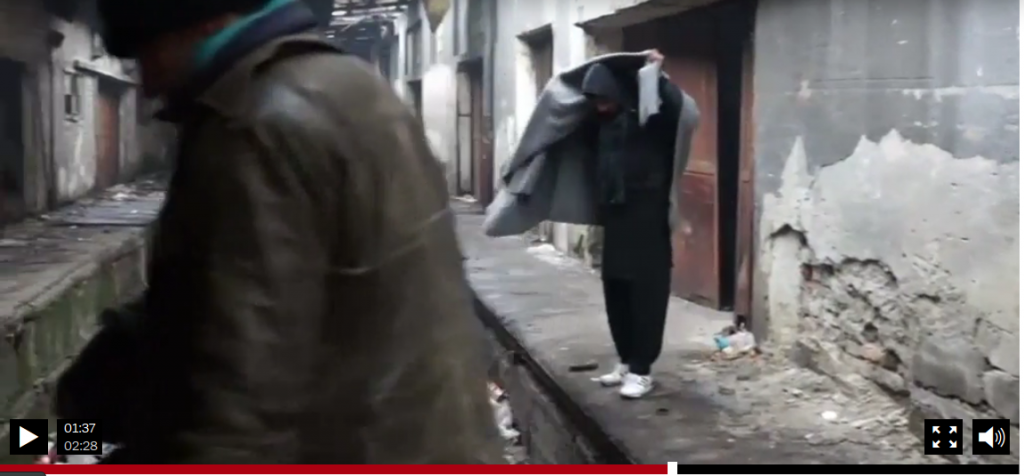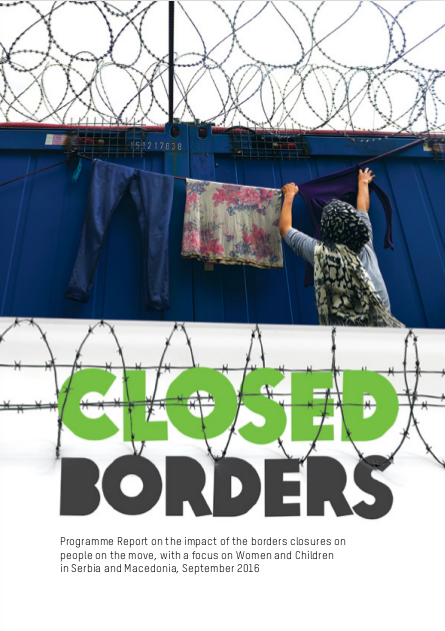A freezing and squalid Belgrade railway depot where up to 2,000 people are seeking shelter from the bitter Serbian winter risks becoming a “new Calais” for refugees and migrants abandoned by European authorities, the humanitarian group Médecins Sans Frontières has warned.Children as young as eight are struggling to survive temperatures that have plunged to -16C this week, with no running water or sanitation.
ARD: Balkanroute – Flüchtlinge in der Sackgasse
Seit Einführung strengerer Grenzkontrollen zu Bulgarien und Mazedonien durch gemischte Militär- und Polizeiteams Ende Juli konnte man laut Behördenangaben gut 15.800 Personen stoppen. Seit Kurzem beteiligen sich auch Sicherheitskräfte aus Ungarn, der Slowakei und Tschechien an diesen gemischten Teams. Die jüngste Drohung des türkischen Präsidenten Recep Tayyip Erdogan über eine mögliche erneute Öffnung der Grenzübergänge für Flüchtlinge wird auch in Belgrad aufmerksam verfolgt. Serbien habe einen „Plan B“ parat, sollte es dazu kommen, berichtete die Tageszeitung „Vecernje novosti“ unter Berufung auf Regierungskreise. Dem Blatt zufolge dürfte in einem solchen Fall erneut der von Regierungschef Aleksandar Vucic wiederholt abgelehnte Zaunbau an den südlichen Grenzen Serbiens in Erwägung gezogen werden. „Wir würden unsere Grenze wirkungsvoll schützen“, wurde Aleksandar Vulin, der für die Flüchtlingskrise zuständige Minister für Arbeits-und Sozialfragen zitiert.Vulin wollte sich zu den Details nicht äußern. In Serbien wird die Flüchtlingszahl von den Behörden derzeit auf etwa 7.000 geschätzt. Rund 5.200 Personen sind landesweit in mehreren Aufnahmezentren untergebracht, der Rest lebt unter freiem Himmel meist im Stadtzentrum Belgrads. Wir konnten in Belgrad einen Flüchtling aus Afghanistan der seit mehreren Monaten festsitzt mit der Kamera begleiten:
HRW: Asylum Seekers Left in the Cold
Temperatures in Hungary and Serbia have dropped to minus 20 degrees centigrade at night. Yet nearly 2,000 asylum seekers and migrants are sleeping rough in Belgrade, in front of Hungary’s “transit zones” on the Serbian border, or inside a tattered government-run tent camp in Hungary without enough aid.
SPIEGEL TV: Flüchtlinge in Serbien – Die Vergessenen
Refugees fall victim to people “ping pong” in the Balkans
In an abandoned warehouse at the back of a bus station in Belgrade, several hundred migrants and refugees, most of them young men from Afghanistan, spend their days trying to keep warm and talking about how they will leave Serbia and continue their journeys towards Western Europe. Officially, since March, there has been no way for migrants and asylum seekers to travel north from Greece other than by successfully applying for family reunification or relocation. But there are options for those who can afford it. Smugglers are charging 1,500 euros to move people from Greece (usually Thessaloniki) to Belgrade, and the same amount again to get them to Western Europe. But many only get as far as the Balkans before running out of money or encountering draconian government policies. Push-backs, detentions, and deportations are common throughout the region, with some activists describing a “ping-pong situation” in which people are endlessly pushed back and forth.
The impact of the borders closures on people on the move, with a focus on women and children in Serbia and Macedonia
This paper provides an analysis of the protection concerns that people on the move, especially women and children, face in Macedonia and Serbia following the closure of the Balkan route and presents recommendations on how to protect and promote their safety, dignity and human rights. This report was conducted by Oxfam and its partners: the Belgrade Center for Human Rights (BCHR) and Atina in Serbia, and the Macedonian Young Lawyer Association (MYLA) and Open Gate/ La Strada in Macedonia. It is based on background research, information gathered by Oxfam partners in the course of their field work, interviews with women and focus group discussions, and meetings with NGO and civil society representatives.
Evictions start in Belgrade: enforced mass transfers from Belgrade to Preševo
On November the 10th in the middle of the night, a big police operation took place behind the main bus station in Belgrade and the parking lot near the so-called “Afghan Park”. 109 people were put into buses and brought to the closed camp in Preševo near the Macedonian border. From here, people are being pushed back on a constant basis. Behind the bus station at the moment more than 700 refugees remain in empty warehouses and around 30 people are currently sleeping in the parking where night temperatures are at an average of 1 degree. During the whole operation, although the people were very scared, they stayed remarkably calm and peaceful. Police did not use actual physical force, but were sometimes deceitful towards the migrants by threatening them and lying over the buses’ destination in order to get them to move from the city.
Serbia’s South: Reception centre in Bujanovac, update Preševo Camp
Until March this year, the camp in Preševo was the entry point for thousands of people from Macedonia into Serbia on their way North. Now, it turned into the opposite: the last stop in Serbia before people are pushed back south, to Macedonia. For several weeks now, the Serbian police has been bringing people on the move to the now closed reception centre in Preševo. These are people that have been staying in camps in the North before, for example in Subotica and Sid as well as in Belgrade. Many people have launched their asylm process in Serbia. Nonetheless, they are pushed-back by the Serbian authorities. It is reported that the Serbian authorities destroies their asylum papers in order to destroy all prove that these people have been in Serbia before. The push-backs are against the all international conventions and violate the asylum right of these people. The push-backs appear to happen in large numbers to make space in the reception centres, as Serbia has not enough spaces in reception centres for all the people currently stranded in Serbia. Except for few unaccompanied minors and families all people who are brought to Preševo camp are subsequently pushed-back to Macedonia. Those vulnerable families and minors have been transferred to a new camp in Bujanovac, 20km north from Preševo.
Flüchtlinge sitzen an serbisch-kroatischer Grenze fest
Rund 100 Flüchtlinge sitzen nach einem 120 Kilometer langen Fußmarsch bei klirrender Kälte an der Grenze zwischen Serbien und dem EU-Land Kroatien fest. Die Flüchtlinge, vor allem junge Männer aus Pakistan und Afghanistan, hatten sich am Freitag in der serbischen Hauptstadt Belgrad auf den Weg zum Grenzübergang Sid gemacht. Serbische und kroatische Polizisten hinderten sie am Montag jedoch daran, über die Grenze in die Europäische Union zu gelangen.
Balkan Insight: Survival Gets Tougher for Migrants Stuck in Serbia
Male migrants are piling up in Belgrade, unable to get into the camps or leave the country – while a ban on NGOs giving them food has made their plight even grimmer.


